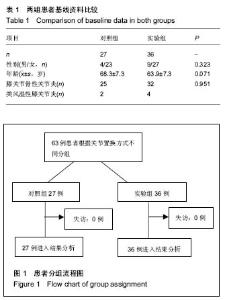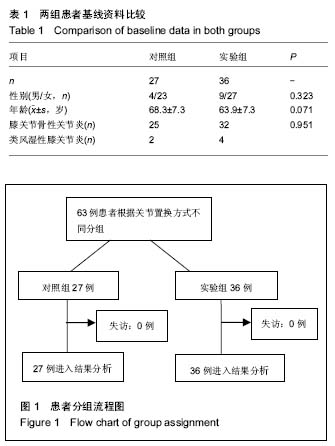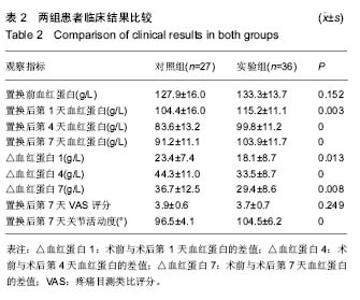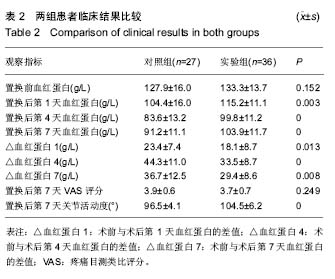| [1] Liu J, Li XF, Xu KL, et al. Bilateral Total Knee Arthroplasty for Charcot Knees Associated with Tabes Dorsalis. Pain Physician.2014;17(6):E796-799.[2] Marya SK, Thukral R. Outcome of unicompartmental knee arthroplasty in octogenarians with tricompartmental osteoarthritis: A longer follow up of previously published report. Indian J Orthop.2013;47(5):459-468.[3] Leung AW, Chan CC, Lee AH, et al. Visual analogue scale 2004;99(1): 235-246.[4] Noticewala MS, Nyce JD, Wang W, et al. Predicting need for allogeneic transfusion after total knee arthroplasty. J Arthroplasty.2012;27(6): 961-967.[5] Bong M, Patel V, Chang E, et al. Risks associated with blood transfusion after total knee arthroplasty. J Arthroplasty.2004;19(3): 281-287.[6] Kalairajah Y, Simpson D, Cossey AJ, et al. Blood loss after total knee replacement: effects of computer-assisted surgery.J Bone Joint Surg Br.2005; 87(11): 1480-1482.[7] Lemaire R. Strategies for blood management in orthopaedic and trauma surgery. J Bone Joint Surg Br.2008;90: 1128- 1136.[8] 高福强,李子剑,张克,等.人工关节置换术后隐性失血计算方法的初步探析[J].中华外科杂志,2011,49(12): 1144.[9] Frisch NB,Wessell NM,Charters MA,et al.Predictors and complications of blood transfusion in total hip and knee arthroplasty.J Arthroplasty.2014;29(9 Suppl): S189-S192.[10] Lotke PA,Faralli VJ,Orenstein EM,et al.Blood loss after total knee replacement: effects of tourniquet release and continuous passive motion. J Bone Joint Surg Am.1991;73(7): 1037-1040.[11] Tetro AM,Rudan JF. The effects of a pneumatic tourniquet on blood loss in total knee arthroplasty. Can J Surg.2001;44:33-38.[12] Xu Li, Lu Yin, Zhao-Yu Chen, Lian Zhu,et al. The effect of tourniquet use in total knee arthroplasty: grading the evidence through an updated meta-analysis of randomized, controlled trials. Eur J Orthop Surg Traumatol.2014;24:973-986.[13] Seo J-G, Moon Y-W, Park S-H, et al. The comparative efficacies of intra-articular and iv tranexamic acid for reducing blood loss during total knee arthroplasty. Knee Surgery, Sports Traumatology, Arthroscopy.2013; 21(8):1869-1874.[14] Alshryda S, Sukeik M, Sarda P, et al. A systematic review and meta-analysis of the topical administration of tranexamic acid in total hip and knee replacement.Bone Joint J.2014;96-B: 1005-1015.[15] Yang ZG, Chen WP, Wu LD. Effectiveness and safety of tranexamic acid in reducing blood loss in total knee arthroplasty: a meta-analysis.J Bone Joint Surg Am.2012; 94:1153-1159.[16] Kim TK, Chang CB, Koh IJ. Practical issues for the use of tranexamic acid in total knee arthroplasty: a systematic review. Knee Surg Sports Traumatol Arthrosc.2014;22:1849-1858.[17] Alexander JW, Korelitz J, Alexander NS. Prevention of wound infections. A case for closed suction drainage to remove wound fluids deficient in opsonic proteins. Am J Surg.1976; 132:59-63.[18] Waugh TR, Stinchfield FE. Suction drainage of orthopaedic wounds. J Bone Joint Surg Am.1961;43: 936-946.[19] Ritter MA, Keating EM, Faris PM. Closed wound drainage in total hip or total knee replacement. A prospective, randomized study.J Bone Joint Surg Am.1994; 76: 35-38.[20] Willett KM, Simmons CD, Bentley G. The effect of suction drains after total hip replacement.J Bone Joint Surg Br. 1988; 70: 607-610. |





